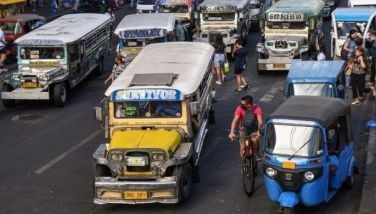Strong 6.4-magnitude quake rocks northern Philippines
MANILA, Philippines — A 6.4-magnitude earthquake rocked the northern Philippines late Tuesday, the US Geological Service said, sending panicked residents out into the streets and causing substantial damage to a hospital.
The quake, caused by a movement of the earth's crust, struck around 10:59 pm (1459 GMT) near the upland town of Dolores.
Staff said they evacuated patients from the 200-bed Mariano Marcos Memorial Hospital in Batac city, about 60 kilometres (37 miles) north of the epicentre, which sustained some of the worst known damage thus far.
Photos of collapsed ceilings in some of the hospital rooms, as well as dozens of patients sat on chairs on the driveway outside were posted on the local fire service's official Facebook page.
"The authorities made us leave the building while they checked the building integrity.... We are currently conducting an assessment of the damage," hospital worker Tom Tabije told AFP by phone.
In Laoag city, near Batac, call centre worker Joffrey Lavarias, 24, filmed screaming co-workers ducking beneath tables inside a high-rise office building as computer monitors on top of the furniture rocked. The lights went out seconds later.
"I thought the earthquake wasn't strong, that's why I decided to film it. After 30 seconds, the shaking suddenly became very strong," he told AFP.
"That's when we hid under our tables," he said, adding they safely evacuated the building shortly after the shaking stopped.
Their employer later sent them home.
The civil defence office in Abra province, where Dolores is located, told AFP there were no immediate reports of casualties, but the extent of the damage would not be known until morning.
The quake, which occurred at a relatively shallow depth of 15.2 kilometres, was felt as far away as the capital Manila, more than 330 kilometres to the south.
Reached by phone, Dolores police patrolman Jeffrey Blanes told AFP that "buildings were shaking so people ran outside."
"We are unable to make a thorough assessment of the impact now because it is nighttime and we are also thinking about our people's safety," Abra rescuer Joel de Leon told AFP by phone.
'Ring of fire'
In July, a 7.0-magnitude quake also in the mountainous Abra province triggered landslides and ground fissures, killing 11 people and injuring several hundred others, according to the official count.
Quakes are a daily occurrence in the Philippines, which sits along the Pacific "Ring of Fire", an arc of intense seismic as well as volcanic activity that stretches from Japan through Southeast Asia and across the Pacific basin.
The nation's civil defence office regularly holds drills simulating earthquake scenarios along active fault lines.
In October 2013, a 7.1-magnitude earthquake struck the central island of Bohol, killing more than 200 people.
That powerful quake altered the island's landscape and a "ground rupture" pushed up a stretch of earth by up to three metres, creating a wall of rock above the epicentre.
- Latest
- Trending
































